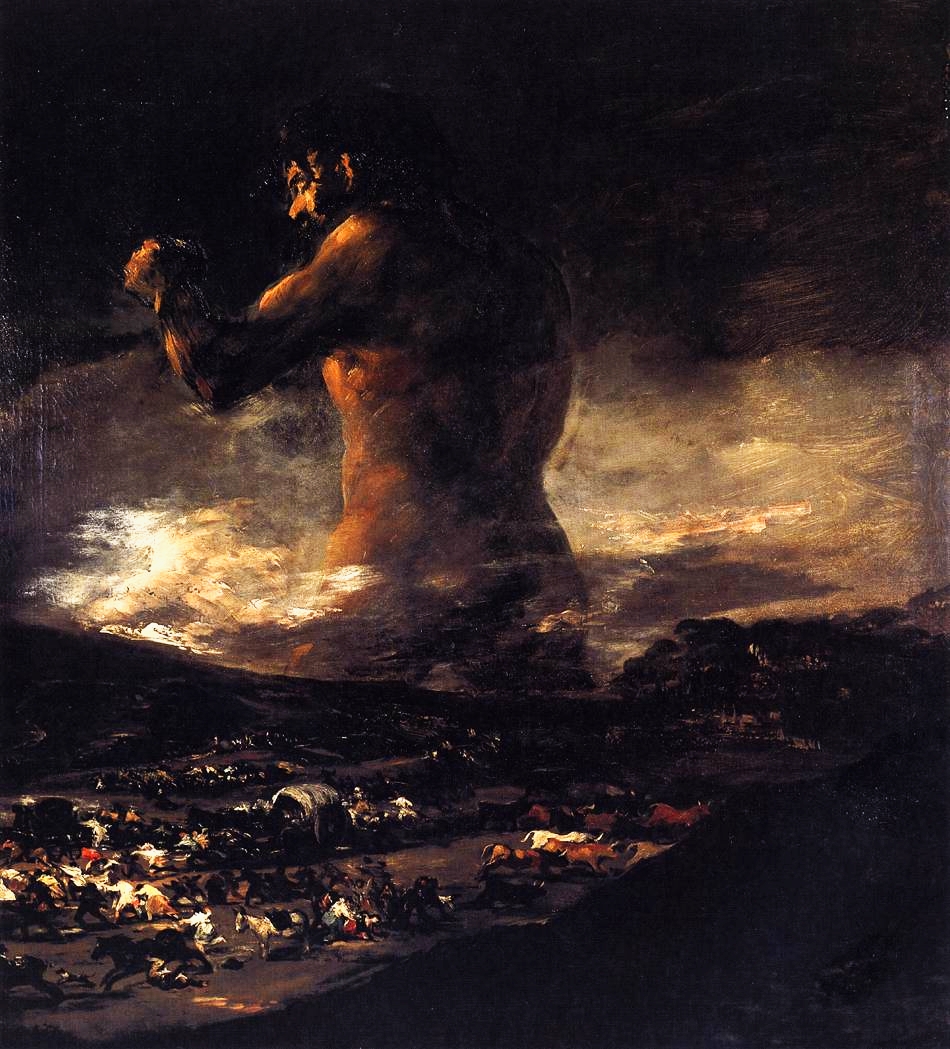- El Coloso
Infobox Painting|

title=El Coloso
artist=Francisco de Goya
year=1808-1812
type=Oil on canvas
height=116
width=105
height_inch=
width_inch =
city=Madrid, Spain
museum=Prado Museum "El Coloso" ("The Colossus") is a celebrated painting that was attributed to
Francisco de Goya . In 2008 thePrado Museum issued a report in which it declared that the painting was "almost with all safety" a work of one of the famous painter's disciples,Asensio Juliá . [ citeweb | url = http://www.elpais.com/articulo/cultura/Coloso/seguro/era/Goya/elpepucul/20080626elpepucul_8/Tes | title = 'El Coloso' "casi seguro" que no era de Goya (Spanish) | publisher = El País | accessdate = 2008-07-13] However,Nigel Glendinning rejects this attribution, pointing out that the arguments contributed by Mena are "totally subjective" and that the alleged signature "A. J." is an inventory number, already well known: 176. Valeriano Bozal, another of the great students of Goyan works, also rejected to take a side on the matter in hopes of learning the depth of the study contributed by Maneula Mena. [ citeweb | url = http://www.elpais.com/articulo/cultura/gigante/Prado/pinto/Goya/elpepicul/20080627elpepicul_3/Tes| title = El gigante del Prado que no pintó Goya (Spanish)| publisher = El País | accessdate = 2008-07-13] [ citeweb | url = http://www.abc.es/20080701/cultura-arte/esta-pasando-grave-triste_200807010257.html| title = Nigel Glendinning: «Lo que está pasando es grave y triste, el Prado admite cosas sin suficiente estudio» (Spanish)| publisher = ABC | accessdate = 2008-07-13]It was painted sometime between 1808 and 1812, the year in which it passed into the possession of de Goya's son, Javier Goya. Subsequently, it belonged to
Pedro Fernández Durán , who bequeathed his collection to thePrado Museum , where it has been kept since 1931. Since 2001, two experts havce put in doubt the belief that it was Goya who painted it. In 2001, Juliet Bareau-Wilson had already declared that "El Coloso" had not been painted by Goya, but by his son, Javier Goya. However, Nigel Glendinning rejected these theories that deny the Goyan authority for these and other paintings. [ citeweb | url = http://www.abc.es/hemeroteca/historico-05-05-2002/abc/Cultura/nigel-glendinning-el-coloso-y-la-lechera-de-burdeos-son-de-goya-y-me-enfada-que-lo-nieguen-sin-demostrarlo_96825.html| title = Nigel Glendinning: «El coloso» y «La lechera de Burdeos» son de Goya y me enfada que lo nieguen sin demostrarlo» (Spanish)| publisher = ABC | accessdate = 2008-07-14]A giant of colossal size that rises from behind some hills —that cover his legs up to the thighs—, occupies the center of the image, surrounded by clouds and with his fists up. The inferior part of the painting (one third of it) is occupied by a shady vale where people and cattle run in every direction.
The work has given place to different interpretations, having received, also, other denominations: "El pánico" ("The Panic") or "La tormenta" ("The Storm").
Analysis
The enormous body of the giant takes up the center of the painting and seems to be in a fighting pose judging by the position of the arms and closed fists. The painting was made during the
Peninsular War , which leads to the notion that the painting symbolized aspects of the war.Nigel Glendinning affirms the painting is based on a patriotic poem, "Profecía del Pirineo" byJuan Bautista Arriaza . In the poem the Spaniard town is presented as a giant raised from thePyrenees to opposeNapoleon 's invasion.There are different interpretations for the giant’s actions and attitude. It is not know whether it is walking or standing firm on his feet. The position is also hard to tell; he could be behind the mountains or buried up to the knees, this usually happens on other
Black Paintings , like "Duelo a garrotazos ". The giant has his eyes closed, which could represent the idea of blind violence. Aside from the giant there are people in the vale that seem to run in every direction, with the exception of a donkey which according to Luna could symbolize the incomprehension of the war phenomenon.The technique of this work is similar to that of the
Black Paintings from theQuinta del Sordo ("Deaf Man's Villa"), a house where Goya lived for some time.References
Wikimedia Foundation. 2010.
